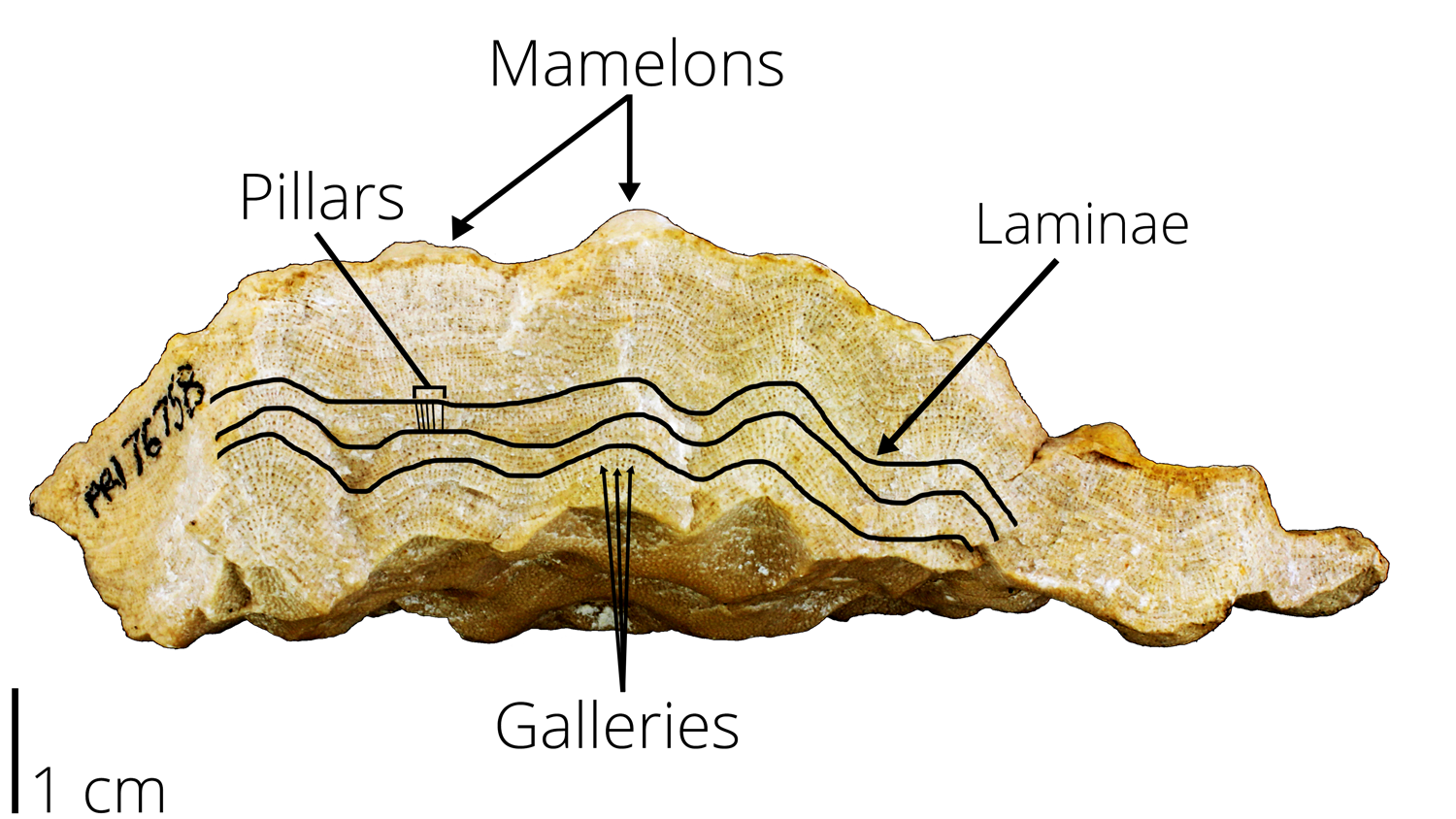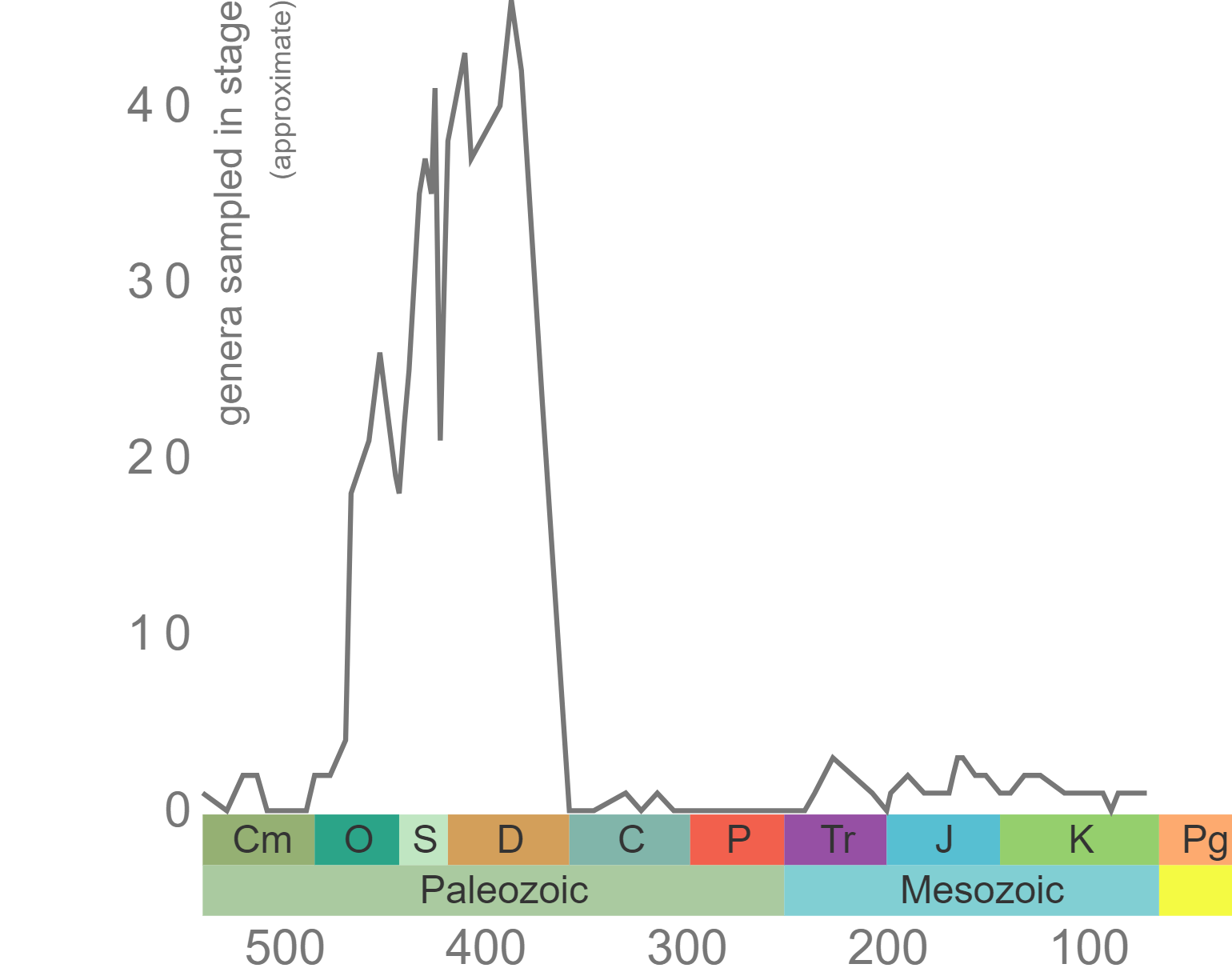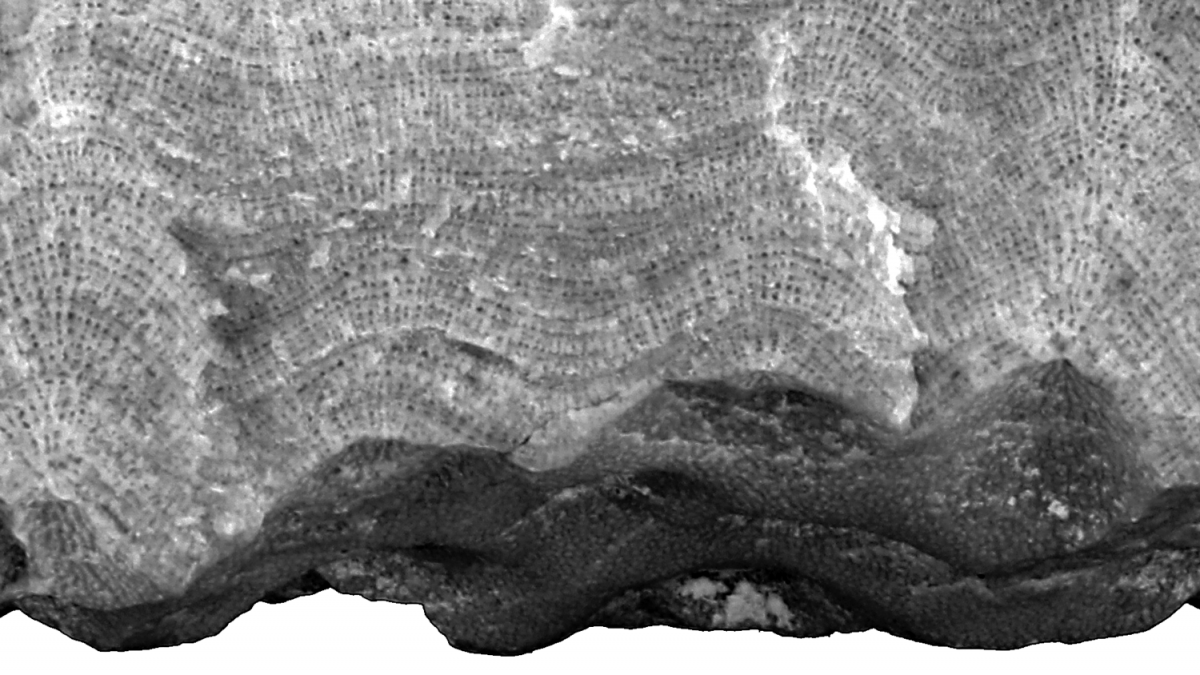Chapter contents:
Porifera
–– 1. Archaeocyatha
–– 2. Stromatoporoidea ←
–– 3. Demospongiae
–– 4. Hexactinellida
–– 5. Calcarea
–– 6. Homoscleromorpha
3D models of Stromatoporoidea can be found here!
Above Image: Cross section of Clathrodictyon sp. (PRI 76758) stromatoporoid layers. Specimen from the collections at the Paleontological Research Institution, Ithaca NY. Image by Jaleigh Q. Pier is licensed under a Creative Commons Attribution-ShareAlike 4.0 International License.
Stromatoporoidea Snapshot:
- Ecology: marine
- Key features of group: calcified, layered reef-builders
- Diversity: 4,938 sp.
- Fossil record: Ordovician to Cretaceous
Overview
Stromatoporoids are best known for being layered calcified ‘sponges’ that were the primary reef-building organisms from the Middle Ordovician to the Late Devonian, before almost being entirely wiped out in the Late Devonian mass extinction.
This group has been controversially classified within the phylum Porifera because—similar to the archaeocyathids—some Paleozoic stromatoporoids lack evidence of spicules, a defining feature of sponges. They also don’t have any receptacles to house polyps like corals so they don't quite fit within phylum Cnidaria either. Due to their strictly fossil record and challenges with definitively classifying their position within phylum Porifera, they are assigned to their own class, Stromatoporoidea.
Why is a stromatoporoid not a stromatolite?
Stromatoporoids are body fossils from a once living animal, whereas stromatolites are sedimentary structures left behind by a microbial mat. Although these fossils may look similar (and have very similar names; "stroma" is the Greek word for layers), they have distinctive characteristics.
Stromatoporoids have an organized structure made up of layers called laminae. Between laminae are vertical structures called pillars and little distinct chambers called galleries. When alive, the galleries would be lined with choanocytes to capture food and respire as water flowed through the layers. These structures are often difficult to see unless the specimen is particularly well preserved. What is often more commonly distinguishable is the bulbous, bumpy surface. Individual bumps are called mamelons, which likely assisted with intake and flow of water through the stromatoporoid. These features are labeled on the figure and 3D models below.

Cross section of Clathrodictyon sp. (PRI 76758) stromatoporpoid highlighting layers. Specimen is from the collections at the Paleontological Research Institution, Ithaca NY. Image by Jaleigh Q. Pier is licensed under a Creative Commons Attribution-ShareAlike 4.0 International License.
Fossil specimen of the stromatoporoid sponge Clathrodictyon sp. from the Devonian Columbus Formation of Ontario, Canada (PRI 76758). Specimen is from the collections of the Paleontological Research Institution, Ithaca, New York. Length of specimen is approximately 10.5 cm.
Fossil specimen of the stromatoporoid Stromatopora sp. from the Silurian Lilley Dolomite Highland County, Ohio (T-261/PRI 43408). Specimen is from the teaching collection of the Paleontological Research Institution, Ithaca, New York. Longest dimension of specimen is approximately 13 cm.
Stromatolites are also layered structures, but otherwise lack complex organization. These fossils are formed by cyanobacterial mats that trap sediment to build a vertical mound that gets them closer to the water surface to soak up the sun required for photosynthesis. These mounds are often uneven and have no internal pillars or chambers. Stromatolites are the oldest structures built by living organisms. Fossils have been found that are over 3.7 billion years old and still grow in some places in our modern world!
Fossil specimen of the stromatolite Collenia versiformis from the Proterozoic of Montana. Specimen is from the Cornell University Paleobotanical Collection (CUPC), Ithaca, New York.
Stromatoporoid Fossil Record
Stromatoporoid fossils are commonly found among crinoids, mollusk, and brachiopod shells, hinting to their ecological importance during the mid-Paleozoic. Sometimes shelled organisms could become enveloped entirely by the growing stromatoporoid, but were still able to live together harmoniously, with water flowing through the stromatoporoid's porous structure. Other organisms associated with stromatoporoid reefs are rugose corals, tabulate corals, bryozoans, worm tubes.
Unlike modern corals, stromatoporoids may not have required hard substrates to grow upon and could instead take advantage of softer substrates. This likely led to their success and dominance over corals in the early to mid-Paleozoic.
During the Jurassic, stromatoporoids had a slight resurgence when their fast growth out competed corals in warm shallow waters of the Tethys sea. They did not reach their previous diversity peak from the Devonian and, for the most part, fringed the outside of already established coral reefs and lagoon environments. By the Mesozoic, many more encrusting organisms had evolved compared to the Paleozoic. This would have caused heightened competition for available reef space, which probably led to the demise of the stromatoporoids which became extinct in the Cretaceous. It should be noted that these Mesozoic stromatoporoids have preserved evidence of spicules and therefore might belong to a different classification from those of the Paleozoic.

Phanerozoic genus-level diversity of "Stromatoporoidea" (graph generated using the Paleobiology Database Navigator).
References and further reading
Boardman, R.S., Cheetham, A.H., and Rowell, A.J. 1987. Fossil Invertebrates. Blackwell Scientific Publications. 713 pp.
Goldfuss, A., 1826. Petrefacta Germaniae (1st ed). Verlag von List and Francke, Dusseldorf, 761.
Kershaw, S. 2013. Palaeozoic stromatoporoid futures: A discussion of their taxonomy, mineralogy and applications in palaeoecology and palaeoenvironmental analysis. Journal of Palaeogeography: 2(2), pp. 163-182.
Kershaw, S., Munnecke, A., and Jarochowska, E. 2018. Understanding Palaeozoic stromatoporoid growth. Earth-Science Reviews: 187, pp. 53-76.
Leinfelder, R.R. et al. 2005. Significance of stromatoporoids in Jurassic reefs and carbonate platforms – concepts and implications. Facies: 51, pp. 287-325.
Nutman, A., P., Bennett, V., C., Friend, C. L. R., Van Kranendonk, M., J., and Chivas, A., R. 2016. Rapid emergence of life shown by discovery of 3,700-million-year-old microbial structures. Nature. 537:535–538.
Stearn, C.W. et al. 1999. Revised classification and terminology of Palaeozoic stromatoporoids. Acta Palaeontologica Polonica: 44(1), pp. 1-70.
Stearn, C. W., 2010a. Morphological affinities of Paleozoic Stromatoporoidea to other fossil and Recent groups. Part E, volume 4, Chapter 9E, Hypercalcified Porifera. Lawrence Press, University of Kansas, Treatise Online, 7: 1-9.
Usage

Unless otherwise indicated, the written and visual content on this page is licensed under a Creative Commons Attribution-NonCommercial-ShareAlike 4.0 International License. This page was written by Jaleigh Q. Pier. See captions of individual images for attributions. See original source material for licenses associated with video and/or 3D model content.



